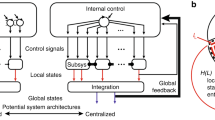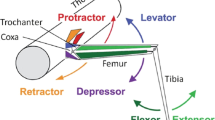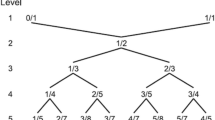Abstract
Rhythmic movement patterns have served as a model case for developing a synergetic theory of biological coordination. In part I of this work we extended the approach to environmentally-specified and learned movement patterns on the level of the collective variable relative phase. Here we show that an identical strategy may be applied to the same problem at the level of the component oscillators. Coordinative patterns and their dynamics are derived from the coupled component dynamics and their interaction with the environment. Thus, behavioral patterns are shown to arise in a purely self-organized fashion. New directions for further research (e.g. dynamics of action-perception systems) follow from the oscillator theory. Finally the relationship between our approach and other kinds of analyses of temporal order (e.g. phase resetting) is addressed.
Similar content being viewed by others
References
Aschoff J (1965) Response curves in circadian periodicity. In: Circadian clocks. North-Holland, Amsterdam, pp 95–111
Bienenstock E, Fogelman Soulié F, Weisbuch G (eds) (1986) Disordered systems and biological organization. Springer, Berlin Heidelberg New York
Bogoliubov NN, Mitropolski YA (1961) Asymptotic methods in the theory of non-linear oscillations, 2nd edn. Gordon and Breach, New York
Daan S, Berde C (1978) Two coupled oscillators: simulations of the circadian pacemaker in mammalian activity rhythms. J Theor Biol 70:297–313
Gibson JJ (1950) The perception of the visual world. Houghton Mifflin, Boston
Grassberger P, Procaccia I (1983) Measuring the strangeness of strange attractors. Physica 9D:189–208
Haken H (1983) Synergetics: an introduction. Nonequilibrium phase transitions and self-organization in physics, chemistry and biology, 3rd edn. Springer, Berlin Heidelberg New York
Haken H (1984) Laser light dynamics. North-Holland, Amsterdam
Haken H, Kelso JAS, Bunz H (1985) A theoretical model of phase transitions in human bimanual coordination. Biol Cybern 51:347–356
Heiligenberg W (1968) Zum Wechselgesang der Heimchen (Acheta domesticus). Kybernetik 68, Beih. Elektronische Rechenanlagen, Bd 18. Oldenburg, München
Holst E von (1939/1973) Relative coordination as a phenomenon and as a method of analysis of central nervous function. Reprinted in: The collected papers of Erich von Holst, University of Miami Press, Coral Gables, Fla
Kay BA (1986) Dynamic modeling of rhythmic limb movements: converging on a description of the component oscillators, Ph. D. Thesis. University of Connecticut, Storrs, Conn
Kay BA, Kelso JAS, Saltzman EL, Schöner G (1987) Space-time behavior of single and bimanual rhythmic movements: data and limit cycle model. J Exp Psych: Hum Perc Perf 13:178–192
Kelso JAS (1981) On the oscillatory basis of movement. Bull Psychon Soc 18:63
Kelso JAS (1984) Phase transitions and critical behavior in human bimanual coordination. Am J Physiol: Reg Integ Comp 15:R1000-R1004
Kelso JAS, Schöner G (1987) Toward a physical (synergetic) theory of biological coordination. In: Graham R, Wunderlin A (eds) Lasers and synergetics. Springer Proceedings in Physics, vol 19, Springer, Berlin Heidelberg New York, pp 224–237
Kelso JAS, Scholz J (1985) Cooperative phenomena in biological motion. In: Haken H (ed) Complex systems — operational approaches in neurobiology, physical systems and computers. Springer, Berlin Heidelberg New York, pp 124–149
Kelso JAS, Tuller B (1987) Intrinsic time in speech production: theory, methodology, and preliminary observations. In: Keller E, Gopnik M (eds) Motor and sensory processes of language. Erlbaum, Hillsdale, NJ, pp 203–222
Kelso JAS, Southard DL, Goodman D (1979) On the nature of human interlimb coordination. Science 203:1029–1031
Kelso JAS, Holt KG, Rubin P, Kugler PN (1981) Patterns of human interlimb coordination emerge from the properties of non-linear limit cycle oscillatory processes: theory and data. J Mot Behavior 13:226–261
Kelso JAS, Scholz J, Schöner G (1986) Nonequilibrium phase transitions in coordinated biological motion: critical fluctuations. Phys Lett A118:279–284
Kelso JAS, Schöner G, Scholz J, Haken H (1987) Phase-locked modes, phase transitions and component oscillators in biological motion. Phys Scr 35:79–87
Kristan WB (1980) Generation of rhythmic motor patterns. In: Pinsker HM, Willis WD (eds) Information processing in the nervous systems. Raven Press, New York
Lee DN, Young DS (1986) Gearing action to environment. In: Heuer H et al. (eds) Generation and modulation of action patterns. Experimental Brain Research Series, vol 15. Springer, Berlin Heidelberg New York
Pavlidis T (1973) Biological oscillators: their mathematical analysis. Academic Press, London
Reichardt WE, Poggio T (eds) (1981) Theoretical approaches in neurobiology. MIT Press, Cambridge, Mass
Schöner G, Haken H, Kelso JAS (1986) A stochastic theory of phase transitions in human hand movement. Biol Cybern 53:247–257
Schöner G, Kelso JAS (1988) A synergetic theory of environmentally-specified and learned patterns of movement coordination. I. Relative phase dynamics. Biol Cybern 58:71–80
Scholz J, Kelso JAS, Schöner G (1987) Nonequilibrium phase transitions in coordinated biological motion: critical slowing down and switching time. Phys Lett A123:390–394
Selverston AI (ed) (1985) Model neural networks and behavior. Plenum Press, New York London
Soechting JP, Terzuolo CA (1986) An algorithm for the generation of curvilinear wrist motion in an arbitrary plane in three-dimensional space. Neuroscience 19:1393–1405
Tuller B., Kelso JAS (1985) Coordination in normal and split-brain patients. Paper presented at Psychonomic Society, Boston, Mass
Tuller B, Kelso JAS (1987) Environmentally-elicited patterns of movement coordination in normal and split-brain subjects. Exp Brain Res (submitted for publication)
Turvey MT (1977) Preliminaries to a theory of action with reference to vision. In: Shaw R, Bransford J (eds) Perceiving, acting and knowing: toward an ecological psychology. Erlbaum, Hillsdale, NJ
Wendler G (1974) The influence of proprioceptive feedback on locust flight coordination. J Comp Physiol 88:173–200
Winfree AT (1980) The geometry of biological time. Springer, Berlin Heidelberg New York
Yamanishi J, Kawato M, Suzuki R (1979) Studies on human finger tapping neural networks by phase transition curves. Biol Cybern 33:199–208
Yamanishi J, Kawato M, Suzuki R (1980) Two coupled oscillators as a model for the coordinated finger tapping by both hands. Biol Cybern 37:219–225
Author information
Authors and Affiliations
Rights and permissions
About this article
Cite this article
Schöner, G., Kelso, J.A.S. A synergetic theory of environmentally-specified and learned patterns of movement coordination. Biol. Cybern. 58, 81–89 (1988). https://doi.org/10.1007/BF00364154
Received:
Accepted:
Issue Date:
DOI: https://doi.org/10.1007/BF00364154




